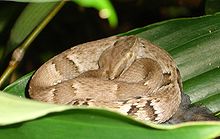- Bothrops jararaca
-
Bothrops jararaca 
Scientific classification Kingdom: Animalia Phylum: Chordata Subphylum: Vertebrata Class: Reptilia Order: Squamata Suborder: Serpentes Family: Viperidae Subfamily: Crotalinae Genus: Bothrops Species: B. jararaca Binomial name Bothrops jararaca
(Wied-Neuwied, 1824)Synonyms - Cophias Jajaraca - Wied-Neuwied, 1824
- Bothrops leucostigma - Wagler, 1824
- Cophias Jararaca - Wied-Neuwied, 1824
- [Cophias] Jararaca - Wied-Neuwied, 1825
- C[ophias]. Jararakka - Wied-Neuwied, 1825
- Cophias Jararaca - Wagler, 1830
- T[rigonocephalus]. jararaca - Schlegel, 1837
- Craspedocephalus brasiliensis - Günther, 1858
- Crotalus Craspedocephalus Brasiliensis - Higgins, 1873
- Bothrops jararaca - Golay et al., 1993[1]
Bothrops jararaca is a venomous pit viper species found in southern Brazil, Paraguay and northern Argentina. The species name is derived from the Tupi words yarará and ca, which means "large snake." Within its range it is often abundant and is an important cause of snakebite.[2] No subspecies are currently recognized.[4]
Contents
Description
This is a slender and terrestrial species that grows to a maximum length of 160 cm (63 in), although the average length is much less.[2]
The head scalation includes 5-12 intersupraoculars that are weakly keeled, 7-9 supralabials (usually 8) of which the second is fused with the prelacunal to form a lacunolabial, and 9-13 sublabials (usually 10-12). Midbody there are 20-27 dorsal scales (usually 23-25). The ventrals number 170-216 (rarely 218) and there are 51-71 subcaudals that are mostly paired.[2]
The color-pattern is extremely variable, consisting of a dorsal ground color that may be tan, brown, gray, yellow, olive, or almost maroon. Midbody, this color is usually somewhat lighter than the head, anterior and posterior. This is overlaid with a series of pale-edged, dark brown subtriangular or trapezoidal markings on either side of the body, the apexes of which reach the vertebral line. These marking may be situated opposite each other, or partially or completely juxtaposed; most specimens have a pattern with all three variations. In juveniles, the tip of the tail is white.[2]
The head has a prominent, dark brown stripe that runs from behind the eye on either side of the head back to the angle of the mouth, usually touching the last three supralabials. Dorsally, this stripe is bordered by a distinct pale area. The tongue is black and the iris is gold to greenish gold with slightly darker reticulations.[2]
Common names
The English common name is jararaca. In Argentina it is called yarará and yararaca perezosa. In Brazil it is referred to as caissaca, jaraca, jaracá, jararaca, jararaca-do-rabo-branco, jararaca-do-campo, jararaca-do-cerrado, jararaca-dormideira, jararaca-dominhoca and malha-de-sapo. In Paraguay and Uruguay it is also called yarará.[2]
Geographic range
Found in southern Brazil, northeastern Paraguay and northern Argentina (Misiones). The type locality is listed as "Lagoa d'Arara am Mucurí" (Brazil) by Wied-Neuwied in 1825.[1] Occurs from near sea level to over 1,000 m altitude.[2]
Habitat
Prefers deciduous tropical forests and savanna country, as well as semi-tropical upland forests. It is said to favor open areas, such as farmland, with nearby vegetation cover.[2]
Feeding
They prey on birds and small mammals.
Reproduction
Ovoviviparous. They are believed to produce about twenty young at a time.
Venom
This species is often abundant within its range, where it is an important cause of snakebite.[2] It is the best-known venomous snake in the wealthy and heavily populated areas of southeastern Brazil, where is was responsible for 52% (3,446 cases) of snakebite between 1902 and 1945 with a 0.7% mortality rate (25 deaths).[5]
The average venom yield is 25-26 mg with a maximum of 300 mg of dried venom. The venom is quite toxic. In mice, the median lethal dose (LD50) is 1.2-1.3 mg/kg intravenous, 1.4 mg/kg intraperitoneal and 3.0 mg/kg subcutaneous. For humans, the LD50 is estimated to be 210 mg subcutaneous.[6]
Typical envenomation symptoms include local swelling, petechiae, bruising and blistering of the affected limb, spontaneous systemic bleeding of the gums and into the skin, subconjunctival hemorrhage and incoagulable blood. The systemic symptoms can potentially be fatal and may involve hemostatic disorders, intracranial hemorrhage, shock and renal failure.[5]
The drugs known as angiotensin converting enzyme inhibitors, which are used for the treatment of hypertension and some types of congestive heart failure, were developed from a peptide found in the venom of this species.
See also
- List of crotaline species and subspecies
- Bothrops by common name
- Bothrops by taxonomic synonyms
- Crotalinae by common name
- Crotalinae by taxonomic synonyms
- Snakebite
References
- ^ a b McDiarmid RW, Campbell JA, Touré T. 1999. Snake Species of the World: A Taxonomic and Geographic Reference, vol. 1. Herpetologists' League. 511 pp. ISBN 1-893777-00-6 (series). ISBN 1-893777-01-4 (volume).
- ^ a b c d e f g h i j Campbell JA, Lamar WW. 2004. The Venomous Reptiles of the Western Hemisphere. Comstock Publishing Associates, Ithaca and London. 870 pp. 1500 plates. ISBN 0-8014-4141-2.
- ^ U.S. Navy. 1991. Poisonous Snakes of the World. US Govt. New York: Dover Publications Inc. 203 pp. ISBN 0-486-26629-X.
- ^ "Bothrops jararaca". Integrated Taxonomic Information System. http://www.itis.gov/servlet/SingleRpt/SingleRpt?search_topic=TSN&search_value=634867. Retrieved 21 January 2007.
- ^ a b Warrell DA. 2004. Snakebites in Central and South America: Epidemiology, Clinical Features, and Clinical Management. In Campbell JA, Lamar WW. 2004. The Venomous Reptiles of the Western Hemisphere. Comstock Publishing Associates, Ithaca and London. 870 pp. 1500 plates. ISBN 0-8014-4141-2.
- ^ Brown JH. 1973. Toxicology and Pharmacology of Venoms from Poisonous Snakes. Springfield, Illinois: Charles C. Thomas. 184 pp. LCCCN 73-229. ISBN 0-398-02808-7.
External links
- Bothrops jararaca at the Reptarium.cz Reptile Database. Accessed 6 December 2007.
Categories:- Bothrops
- Fauna of Brazil
- Reptiles of Argentina
- Fauna of Paraguay
Wikimedia Foundation. 2010.
